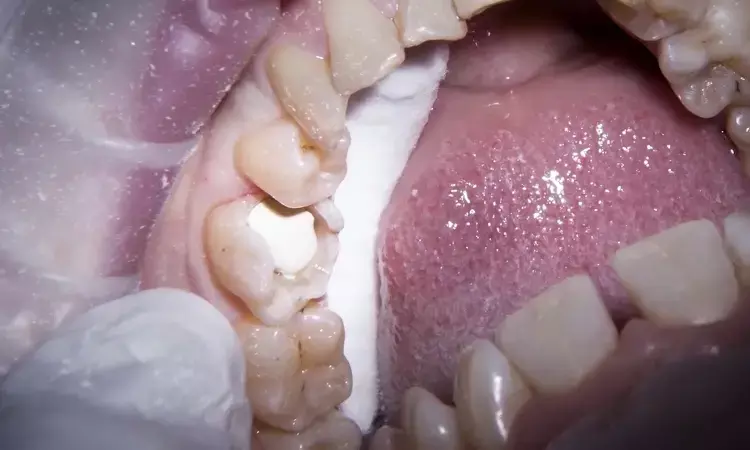- Home
- Medical news & Guidelines
- Anesthesiology
- Cardiology and CTVS
- Critical Care
- Dentistry
- Dermatology
- Diabetes and Endocrinology
- ENT
- Gastroenterology
- Medicine
- Nephrology
- Neurology
- Obstretics-Gynaecology
- Oncology
- Ophthalmology
- Orthopaedics
- Pediatrics-Neonatology
- Psychiatry
- Pulmonology
- Radiology
- Surgery
- Urology
- Laboratory Medicine
- Diet
- Nursing
- Paramedical
- Physiotherapy
- Health news
- Fact Check
- Bone Health Fact Check
- Brain Health Fact Check
- Cancer Related Fact Check
- Child Care Fact Check
- Dental and oral health fact check
- Diabetes and metabolic health fact check
- Diet and Nutrition Fact Check
- Eye and ENT Care Fact Check
- Fitness fact check
- Gut health fact check
- Heart health fact check
- Kidney health fact check
- Medical education fact check
- Men's health fact check
- Respiratory fact check
- Skin and hair care fact check
- Vaccine and Immunization fact check
- Women's health fact check
- AYUSH
- State News
- Andaman and Nicobar Islands
- Andhra Pradesh
- Arunachal Pradesh
- Assam
- Bihar
- Chandigarh
- Chattisgarh
- Dadra and Nagar Haveli
- Daman and Diu
- Delhi
- Goa
- Gujarat
- Haryana
- Himachal Pradesh
- Jammu & Kashmir
- Jharkhand
- Karnataka
- Kerala
- Ladakh
- Lakshadweep
- Madhya Pradesh
- Maharashtra
- Manipur
- Meghalaya
- Mizoram
- Nagaland
- Odisha
- Puducherry
- Punjab
- Rajasthan
- Sikkim
- Tamil Nadu
- Telangana
- Tripura
- Uttar Pradesh
- Uttrakhand
- West Bengal
- Medical Education
- Industry
Atraumatic restorative treatment may be first line treatment for primary dentine carious lesion

Atraumatic restorative treatment and/or other evidence-based atraumatic care procedures should be the first treatment for a primary dentine carious lesion, according to a recent study published in the British Dental Journal.
Too many people worldwide suffer from the consequences of untreated dentine carious lesions. This finding reflects the inability of the currently used traditional mode of treatments to manage such lesions. A change is needed. Dental training institutions should depart from the traditional 'drill and fill' treatments and embrace the holistic oral healthcare approach that is minimal intervention dentistry (MID) and includes within it minimally invasive operative skills. Dental caries is, after all, a preventable disease. The atraumatic restorative treatment (ART) concept is an example of MID. ART consists of a preventive (ART sealant) and a restorative (ART restoration) component.
ART sealants using high-viscosity glass-ionomer (HVGIC) have a very high dentine carious lesion preventive effect. The survival rate of these sealants is not significantly different from that of sealants produced with resin. The survival rate of ART/HVGIC restorations matches those of amalgam and resin composite in single- and multiple-surface cavities in primary teeth and in single-surface cavities in permanent teeth. The principles of carious tissue removal within a cavity recommended by the International Caries Consensus Collaboration are in line with those of treating a cavity using ART. Owing to its good performance and the low levels of discomfort/pain and dental anxiety associated with it, ART and/or other evidence-based atraumatic care procedures should be the first treatment for a primary dentine carious lesion.
Thus, only if the use of ART is not indicated should other more invasive and less-atraumatic care procedures be used in both primary and permanent dentitions.
Reference:
Atraumatic restorative treatment and minimal intervention dentistry by J. E. Frencken published in the British Dental Journal
https://doi.org/10.1038/sj.bdj.2017.664
Dr. Shravani Dali has completed her BDS from Pravara institute of medical sciences, loni. Following which she extensively worked in the healthcare sector for 2+ years. She has been actively involved in writing blogs in field of health and wellness. Currently she is pursuing her Masters of public health-health administration from Tata institute of social sciences. She can be contacted at editorial@medicaldialogues.in.
Dr Kamal Kant Kohli-MBBS, DTCD- a chest specialist with more than 30 years of practice and a flair for writing clinical articles, Dr Kamal Kant Kohli joined Medical Dialogues as a Chief Editor of Medical News. Besides writing articles, as an editor, he proofreads and verifies all the medical content published on Medical Dialogues including those coming from journals, studies,medical conferences,guidelines etc. Email: drkohli@medicaldialogues.in. Contact no. 011-43720751


